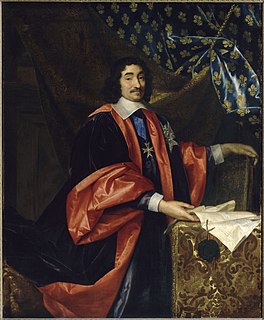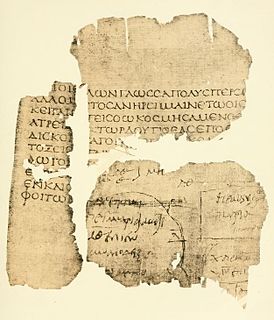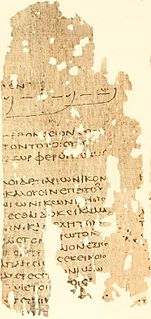Writings
In one, they are found among those scholia on the works of Homer transmitted in Byzantine manuscripts as the so-called "D-scholia". [2] In the other, recently recovered manuscript tradition, a 3rd-century CE papyrus, conserved at Berlin, [3] of the source or one based on it has provided a parallel text, confirming the text offered by Mythographus Homericus. [4] There are several fragmentary papyri, four of them from Oxyrhynchus, providing additional evidence. They date from the first or second to the fifth century CE; seventy-seven fragments relating to Iliad 18-24 were published in 1995 as P. Oxy. LXI 4096. [5]
In distinction from the texts interspersed among the Homeric D-scholia, where the actual individual authors are submerged in sources that are merely cited as scholia, the papyrus text preserves the original format in which these summary histories were transmitted. [6] They follow the canonic Homeric text, with headwords or lemmata that link them to the relevant Homeric line. Most of them are brief accounts of an episode or etiologies of names, genealogies or explanations of an Homeric term; they do not provide a grammarian's gloss. [7]

Homer is the legendary author of the Iliad and the Odyssey, two epic poems that are the central works of ancient Greek literature. The Iliad is set during the Trojan War, the ten-year siege of the city of Troy by a coalition of Greek kingdoms. It focuses on a quarrel between King Agamemnon and the warrior Achilles lasting a few weeks during the last year of the war. The Odyssey focuses on the ten-year journey home of Odysseus, king of Ithaca, after the fall of Troy. Many accounts of Homer's life circulated in classical antiquity, the most widespread being that he was a blind bard from Ionia, a region of central coastal Anatolia in present-day Turkey. Modern scholars consider these accounts legendary.
The name Astyoche or Astyocheia was attributed to the following individuals in Greek mythology.

Among the Dead Sea scrolls, 7Q5 is the designation for a small Greek papyrus fragment discovered in Qumran Cave 7 and dated before anyone claimed to be able to identify it by its style of script as likely having been written sometime between 50 B.C. and 50 A.D. The significance of this fragment is derived from an argument made by Spanish papyrologist Jose O'Callaghan in his work ¿Papiros neotestamentarios en la cueva 7 de Qumrân? in 1972, later reasserted and expanded by German scholar Carsten Peter Thiede in his work The Earliest Gospel Manuscript? in 1982. The assertion is that the previously unidentified 7Q5 is actually a fragment of the Gospel of Mark, chapter 6 verse 52-53. The majority of scholars have not been convinced by O'Callaghan's and Thiede's identification and it is "now virtually universally rejected". While scholars of the text of the Bible have rejected Thiede’s claims; a majority of the papyrological scientists who actually study artifacts from antiquity accepted O’Callaghan and Thiede’s assertions. The results of the 1991 symposium demonstrated that most papyrologists agreed with them based on Papyrologist Hebert Hungers 22 point analysis and President of Papyrological Association Orsolina Montevecchi statement that there can be no doubt that 7Q5 is a copy of Mark’s Gospel

The "Magdalen" papyrus was purchased in Luxor, Egypt in 1901 by Reverend Charles Bousfield Huleatt (1863–1908), who identified the Greek fragments as portions of the Gospel of Matthew and presented them to Magdalen College, Oxford, where they are cataloged as P. Magdalen Greek 17 and whence they have their name. When the fragments were finally published by Colin H. Roberts in 1953, illustrated with a photograph, the hand was characterized as "an early predecessor of the so-called 'Biblical Uncial'" which began to emerge towards the end of the 2nd century. The uncial style is epitomised by the later biblical Codex Vaticanus and Codex Sinaiticus. Comparative paleographical analysis has remained the methodological key for dating the manuscript, but there is no consensus on the dating of the papyrus. Estimates have ranged from the first century to the fourth century AD.

Stichometry refers to the practice of counting lines in texts: Ancient Greeks and Romans measured the length of their books in lines, just as modern books are measured in pages. This practice was rediscovered by German and French scholars in the 19th century. Stichos is the Greek word for a 'line' of prose or poetry and the suffix '-metry' is derived from the Greek word for measurement.

Homeric scholarship is the study of any Homeric topic, especially the two large surviving epics, the Iliad and Odyssey. It is currently part of the academic discipline of classical studies. The subject is one of the oldest in scholarship. For the purpose of the present article, Homeric scholarship is divided into three main phases: antiquity; the 18th and 19th centuries; and the 20th century and later.

Venetus A is the more common name for the tenth century AD manuscript catalogued in the Biblioteca Marciana in Venice as Codex Marcianus Graecus 454, now 822.
Dr. Josep O'Callaghan Martínez, SJ was a Spanish Jesuit Catholic priest, papyrologist and Biblical scholar. He is known for his identification of the 7Q5 papyrus of Qumran with a text of Mark 6, 52–53.

The Papyrology Collection of the University of Michigan Library is an internationally respected collection of ancient papyrus and a center for research on ancient culture, language, and history. With over 7,000 items and more than 10,000 individual fragments, the Collection is by far the largest collection of papyrus in the country, and offers a glimpse into the everyday life and language of the ancient world. Of keen interest to historians, linguists, classicists, philosophers, archaeologists, as well as others, the collection includes biblical fragments, religious writings, public and private documents, private letters, and writings on astronomy, astrology, mathematics, and magic. The papyri span nearly two millennia of history, dating from about 1000 BC to AD 1000, with the majority dating from the third century BC to the seventh century AD.

Fonds Coislin is a collection of Greek manuscripts acquired by Pierre Séguier, but named after Henri-Charles de Coislin, its second owner. It is now held in the National Library of France, as one of three fonds of Greek manuscripts: fonds grec, fonds Coislin, and supplément grec.
Uncial 069, ε 12 (Soden), is a Greek uncial manuscript of the New Testament, dated paleographically to the 5th century.
Papyrus 91, designed by 91, is an early copy of the New Testament in Greek. It is a papyrus manuscript of the Acts of Apostles. The surviving texts of Acts are verses 2:30-37; 2:46-3:2. The manuscript paleographically has been assigned to the middle of the 3rd century.

Papyrus 114, designated by 114, is a copy of the New Testament in Greek. It is a papyrus manuscript of the Letter to the Hebrews, containing verses 1:7-12 in a fragmentary condition. The manuscript has been paleographically assigned by the INTF to the 3rd century CE. Papyrologist Philip Comfort dates the manuscript to Middle-Late 3rd century CE. The manuscript is currently housed in the Papyrology Rooms of the Sackler Library at Oxford.
Guido Bastianini, Italian papyrologist and palaeographer.

Papyrus Oxyrhynchus 20 consists of twelve fragments of the second book of the Iliad, written in Greek. It was discovered by Grenfell and Hunt in 1897 in Oxyrhynchus. The fragment is dated to the second century. It is housed in the British Library. The text was published by Grenfell and Hunt in 1898.

Papyrus Oxyrhynchus 220 is a treatise on prosody, written by an unknown author in Greek. It was discovered in Oxyrhynchus. The manuscript was written on papyrus in the form of a roll. It is dated to the first century or second century AD. Currently it is housed in the British Library in London.

Papyrus Oxyrhynchus 221 contains Homeric scholia by an unknown author, written in Greek. It was discovered in Oxyrhynchus, Egypt. The manuscript was written on papyrus in the form of a roll. It is dated to the second century. Frederic G. Kenyon dated it to the first century or the first half of the second century. Currently it is housed in the British Library in London.
William Hailey Willis was an American classicist and a leading twentieth century papyrologist.
Petra Marieke Sijpesteijn is professor of Arabic at Leiden University. She was the founding president of the International Society for Arabic Papyrology.

The Vision of Dorotheus or Dorotheos is an autobiographical Homeric Greek poem, composed in 343 lines of dactylic hexameter and attributed to "Dorotheus, son of Quintus the Poet". The poem chronicles a vision, wherein the author is transported to the Kingdom of Heaven and finds himself in its military hierarchy. He is conscripted into and deserts his post, only to receive punishment, be forgiven, and rediscover his Christian faith. The poem, penned sometime in the 4th-century, depicts the Kingdom of Heaven in an Imperial fashion; Christ is enthroned as emperor, surrounded by angels bearing Roman military and official titles, with the military structures of the Kingdom of Heaven modelled on those of Rome.











